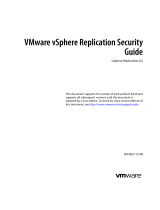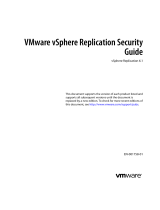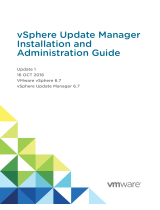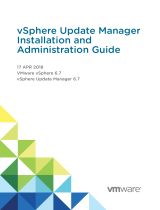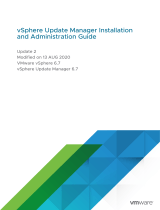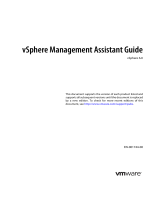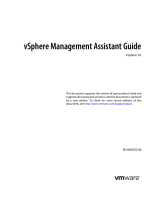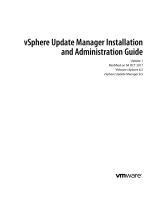Page is loading ...

iDRAC Service Module 2.0
Installation Guide

Notes, Cautions, and Warnings
NOTE: A NOTE indicates important information that helps you make better use of your computer.
CAUTION: A CAUTION indicates either potential damage to hardware or loss of data and tells you
how to avoid the problem.
WARNING: A WARNING indicates a potential for property damage, personal injury, or death.
Copyright © 2014 Dell Inc. All rights reserved. This product is protected by U.S. and international copyright and
intellectual property laws. Dell
™
and the Dell logo are trademarks of Dell Inc. in the United States and/or other
jurisdictions. All other marks and names mentioned herein may be trademarks of their respective companies.
2014 - 09
Rev. A00

Contents
1 Introduction........................................................................................................... 5
New in this release................................................................................................................................ 5
iDRAC Service Module monitoring features.........................................................................................5
Operating system information........................................................................................................ 5
Lifecycle Controller log replication into operating system........................................................... 6
Automatic system recovery feature................................................................................................6
Windows Management Instrumentation Providers........................................................................6
Automatic Technical Support Report collection............................................................................6
Prepare to remove NVMe PCIe SSD device....................................................................................7
Supported features — operating systems matrix................................................................................. 7
Co-existence of Server Administrator and iDRAC Service Module.....................................................8
Software availability...............................................................................................................................8
Downloading iDRAC Service Module...................................................................................................8
Accessing documents from Dell support site......................................................................................8
Software license agreement................................................................................................................. 9
Other documents you may need......................................................................................................... 9
2 Preinstallation setup.......................................................................................... 10
Installation requirements.................................................................................................................... 10
Supported operating systems.............................................................................................................10
Supported platforms............................................................................................................................11
System requirements...........................................................................................................................12
3 Installing the iDRAC Service Module on Microsoft Windows
operating systems..................................................................................................13
Installing the iDRAC Service Module on Microsoft Windows operating systems.............................13
Silent installation............................................................................................................................13
Modifying the iDRAC Service Module components on Microsoft Windows operating systems.....14
Repairing the iDRAC Service Module on Microsoft Windows operating systems............................14
Uninstalling the iDRAC Service Module on Microsoft Windows operating systems........................ 15
Unattended uninstall using the product ID.................................................................................. 15
Uninstalling using the add/remove feature.................................................................................. 15
4 Installing iDRAC Service Module on supported Linux operating
system...................................................................................................................... 16
Preinstallation requirement for Linux operating system....................................................................16
Linux install dependency.....................................................................................................................16
Installing The iDRAC Service Module on Linux operating system.....................................................17

Silent installation............................................................................................................................18
Uninstalling the iDRAC Service Module on Linux operating system.................................................18
Uninstalling the iDRAC Service Module using the uninstall script...............................................18
Uninstalling the iDRAC Service Module using the RPM command.............................................18
5 Installing the iDRAC Service Module on VMware ESXi................................ 19
Using the vSphere CLI......................................................................................................................... 19
Using the VMware vSphere Management Assistant.......................................................................... 20
Using the VMware Update Manager.................................................................................................. 20
Using the Power CLI............................................................................................................................21
6 Installing the iDRAC Service Module on Citrix XenServer.......................... 22
Installing the iDRAC Service Module on Citrix XenServer on a running system...............................22
Installing the iDRAC Service Module on Citrix XenServer during XenServer installation................. 23
7 Configuring the iDRAC Service Module......................................................... 24
Configuring The iDRAC Service Module From iDRAC Web Interface.............................................. 24
Configuring the iDRAC Service Module from RACADM....................................................................24
Configuring the iDRAC Service Module from WSMAN......................................................................25
8 Frequently asked questions..............................................................................26
Do I need to uninstall Open Manage Server Administrator before installing or running the
iDRAC Service Module?...................................................................................................................... 26
How do I know that the iDRAC Service Module is installed in my system?..................................... 26
How do I know which version of the iDRAC Service Module I have in my system?........................26
What is the minimum permission level required to install the iDRAC Service Module?..................26
Whenever I try to install the iDRAC Service Module, it shows an error message This is not a
supported server. Consult the User Guide for additional information about the supported
servers. What should I do now?..........................................................................................................27
I see the messageThe iDRAC Service Module is unable to communicate with iDRAC using
the OS to iDRAC Pass-through channel in the OS log, even when the OS to iDRAC Pass-
through over USBNIC is configured properly. Why do I get this message?..................................... 27
Whenever I try to install the iDRAC Service Module, an error message This operating system
is not supported is displayed.............................................................................................................. 28
When I uninstall iDRAC Service Module from a VMware ESXi server, I see the virtual switch is
named as “vSwitchiDRACvusb” and port group as “iDRAC Network” on the Vsphere client.
How do I delete them?....................................................................................................................... 28
Where do I find the Replicated LifeCycle log on my Operating System?........................................ 28
What are the Linux dependent packages or executables I should install while completing the
Linux installation?................................................................................................................................28
9 Linux installer packages.................................................................................... 29

1
Introduction
This guide provides information and step-by-step instructions on how to install iDRAC Service Module on
the supported operating systems.
The Integrated Dell Remote Access Controller(iDRAC) Service Module is a lightweight optional software
application that can be installed on Dell’s 12
th
generation of PowerEdge servers or later. The iDRAC
Service Module complements iDRAC interfaces – Graphical User Interface (GUI), RACADM CLI and Web
Service Management (WSMAN) with additional monitoring data. You can configure the features on the
supported operating system depending on the features to be installed and the unique integration needs
in your environment.
The iDRAC Service Module architecture uses IP socket communication and provides additional Systems
Management data (OS/device driver) to iDRAC and presents one-to-many consoles with access to
Systems Management data through OS standard interfaces.
New in this release
• Support for Dell’s 13
th
generation of PowerEdge servers. For the list of supported platforms, see
Supported platforms
• Windows Management Instrumentation (WMI) Management Providers
• Sharing of operating system (OS) and network information
• Prepare to remove Non-Volatile Memory Express (NVMe) Pheripheral Component Interconnect
Express (PCIe) Solid State Device (SSD)
• Automatic Technical Support Report (TSR) OS log collection
iDRAC Service Module monitoring features
The services provided are:
• OS information
• Lifecycle Controller Log replication into operating system
• Automatic system recovery
• Windows Management Instrumentation providers inclusive of storage data
• Automatic Technical Support Report collection
• Prepare to remove NVMe SSD device
Operating system information
Server Administrator currently shares operating system information and host name with iDRAC. The
iDRAC Service Module provides similar information such as host OS name, server host IP address
information, OS version, Fully Qualified Domain Name (FQDN) with iDRAC. The network interfaces on the
5

host OS are also displayed. By default, this monitoring feature is enabled. This feature is available even if
Server Administrator is installed on the host OS.
Lifecycle Controller log replication into operating system
Replicates the Lifecycle Controller (LC) logs to the OS logs. All events that have the OS Log option as the
target (in the Alerts page or in the equivalent RACADM or WSMAN interfaces) are replicated in the OS log
using the iDRAC Service Module. This is similar to the System Event Log (SEL) replication performed by
Server Administrator.
The default set of logs to be included in the OS logs are the same as the logs configured for SNMP traps/
alerts. Only the events logged in the LC log after the iDRAC Service Module was installed are replicated to
the OS Log. If Server Administrator is installed, the monitoring feature is disabled to avoid duplicate SEL
entries in the OS log.
Automatic system recovery feature
Automatic System Recovery feature is a hardware-based timer, which is used to reset the server in the
event of a hardware failure. You can perform automatic system recovery operations such as reboot,
power cycle, or power off after a specified time interval. This feature is enabled only when the operating
system watchdog timer is disabled. If Server Administrator is installed, the monitoring feature is disabled
to avoid duplicate watchdog timers.
Windows Management Instrumentation Providers
Windows Management Instrumentation Providers available with iDRAC Service Module exposes hardware
data through Windows Management Instrumentation (WMI). WMI is a set of extensions to the Windows
Driver Model that provides an operating system interface through which instrumented components
provide information and notification. WMI is Microsoft's implementation of the Web-Based Enterprise
Management (WBEM) and Common Information Model (CIM) standards from the Distributed
Management Task Force (DMTF) to manage Server hardware, operating systems and applications. WMI
Providers helps to integrate with Systems Management Consoles such as Microsoft System Center and
enables scripting to manage Microsoft Windows Servers.
Automatic Technical Support Report collection
The Technical Support Report (TSR) feature in iDRAC collects information about the hardware, OS and
relevant application data and compresses this information. Currently, you have to manually run the OS
Collector tool to generate the TSR. Using iDRAC Service Module 2.0, the OS Collector tool automatically
collects relevant OS and hardware information. Automatic Support Log collection including OS and
Application Information Collection with TSR.
By using iDRAC Service Module you reduce the number of manual steps to collect the Technical Support
Report as the collection process is automated.
NOTE: This feature is available by default when you install iDRAC Service Module 2.0 on systems
running supported Microsoft and Linux operating systems. You cannot disable the feature.
NOTE: The OS log collection feature of Automatic Technical Support Report is not supported on
CentOS.
6

Prepare to remove NVMe PCIe SSD device
You can remove a Non-Volatile Memory Express (NVMe) Pheripheral Component Interconnect Express
(PCIE) Solid State Device (SSD) without shutting down or rebooting the system. When you are removing a
device, all the activities associated with the device must be stopped to prevent data loss. To prevent loss
of data use the Prepare to Remove option, which stops all the device-associated background activities,
after which you can remove the NVMe PCIe SSD physically.
Supported features — operating systems matrix
The following is the list of supported features and the operating system.
Features Operating Systems
Microsoft
Windows
Linux Virtualization
12th generation
and 13th
generation
Sharing OS
Information
Yes Yes Yes
12th generation
and 13th
generation
LC Log
Replication
Yes Yes Yes
12th generation
and 13th
generation
Automatic System
Recovery/
Watchdog
Yes Yes Yes
13th generation
Windows
Management
Instrumentation
Providers
Yes No No
13th generation
Prepare to
Remove NVMe
device through
iDRAC
Yes Yes No
13th generation
Automating
Technical Support
Report OS
collection
Yes Yes No
NOTE: The new features such as Windows Management Instrumentation Providers, Prepare to
Remove NVMe device through iDRAC, Automating Technical Support Report OS collection are
supported only on Dell’s 13
th
generation of PowerEdge servers with minimum firmware version of
2.00.00.00 or later.
NOTE: For the list of platforms supported by iDRAC Service Module, see Supported operating
systems.
7

Co-existence of Server Administrator and iDRAC Service
Module
In a system, both Server Administrator and the iDRAC Service Module can co-exist. If you have enabled
the monitoring features during the iDRAC Service Module installation, then after the installation is
complete, if the iDRAC Service Module detects the presence of Server Administrator, iDRAC Service
Module disables the set of monitoring features that overlap. The iDRAC Service Module keeps polling
Server Administrator and its features. At any time if the Server Administrator service stops, the respective
iDRAC Service Module feature is enabled.
Software availability
The iDRAC Service Module software is available on the
• Systems Management Tools and Documentation (SMTD) DVD
• Support site — dell.com/support
Downloading iDRAC Service Module
You can download the iDRAC Service Module software from dell.com/support/home .
Accessing documents from Dell support site
You can access the required documents in one of the following ways:
• Using the following links:
– For all Enterprise Systems Management documents — dell.com/softwaresecuritymanuals
– For Enterprise Systems Management documents — dell.com/openmanagemanuals
– For Remote Enterprise Systems Management documents — dell.com/esmmanuals
– For OpenManage Connections Enterprise Systems Management documents — dell.com/
OMConnectionsEnterpriseSystemsManagement
– For Serviceability Tools documents — dell.com/serviceabilitytools
– For Client Systems Management documents — dell.com/clientsystemsmanagement
– For OpenManage Connections Client Systems Management documents — dell.com/
connectionsclientsystemsmanagement
• From the Dell Support site:
a. Go to dell.com/support/home.
b. Under General support section, click Software & Security.
c. In the Software & Security group box, click the required link from the following:
– Enterprise Systems Management
– Remote Enterprise Systems Management
– Serviceability Tools
8

– Client Systems Management
– Connections Client Systems Management
d. To view a document, click the required product version.
• Using search engines:
– Type the name and version of the document in the search box.
Software license agreement
The software license for the supported versions of the operating system of the iDRAC Service Module is
on the installer. Read the license_agreement.txt file. By installing or copying any of the files on the
media, you are agreeing to the terms in license_agreement.txt file.
Other documents you may need
In addition to this guide, you can access the following guides available at dell.com/support/home.
• The Integrated Dell Remote Access Controller (iDRAC) User’s Guide provides detailed information on
configuring, and using the iDRAC.
• The Dell Remote Access Controller Racadm User's Guide provides information about using the
Racadm command-line utility.
• The Dell Update Packages User's Guide provides information about obtaining and using Dell Update
Packages as part of your system update strategy.
• The Dell Event Messages Reference Guide provides information on the event and error information
generated by firmware and other agents that monitor system components.
• The Dell Lifecycle Controller 2 Web Services Interface Guide provides information and examples for
utilizing the Web services for Management (WS-Man) Management protocol.
9

2
Preinstallation setup
Ensure that you assess the following before installing the iDRAC Service Module:
• Dell’s 12
th
generation of PowerEdge or later servers. For the list of supported platforms, see Supported
platforms.
• Minimum firmware version — For iDRAC7 1.57.57 or later and for iDRAC8 2.00.00.00 or later.
NOTE: If you install iDRAC Service Module 2.0 on iDRAC7 1.5x.5x, you cannot use the new
features provided by iDRAC Service Module 2.0. However, you get the features of iDRAC Service
Module 1.0.
• Read the installation instructions for the operating system.
• Read the applicable release notes files and the Systems Software Support Matrix.
• Read the Installation Requirements to ensure that the system meets or exceeds the minimum
requirement.
• Close all applications running on the system before installing the iDRAC Service Module application.
NOTE: The new features in iDRAC Service Module 2.0 are available on Dell’s 13
th
generation of
PowerEdge or later servers.
Installation requirements
This section describes the general requirements of the iDRAC Service Module and provides information
on supported operating systems and the basic system requirements.
Windows
• Microsoft Windows 2008 x64 SP2, Windows 2008 R2 SP1, Windows 2012, or
Windows 2012 R2 operating system.
• Administrator privileges.
Linux
• Red Hat Enterprise Linux 6.5, Red Hat Enterprise Linux 7, SUSE Linux Enterprise
Server 11 SP3 operating system.
NOTE: Prerequisites specific to an operating system are listed as part of the installation procedures.
NOTE: The iDRAC Service Module can be installed using an User Interface. The installer also
supports a silent installation mechanism.
Supported operating systems
The iDRAC Service Module support is available on the following 64–bit operating system:
• Microsoft Windows Server 2008 SP2
• Microsoft Windows Server 2008 R2 SP1
10

• Microsoft Windows 2012
• Microsoft Windows 2012 R2
• Red Hat Enterprise Linux 6.5
• Red Hat Enterprise Linux 7
• SUSE Linux Enterprise Server 11 SP3
• VMware ESXi 5.1 U2
• VMware ESXi 5.5 U2
• Citrix XenServer 6.2 SP1
• CentOS 5.9*
• CentOS 6.5*
* — iDRAC Service Module can be installed on CentOS version 5.9 and 6.5. Dell provides only limited
support for CentOS. For more information or support on CentOS, contact the CentOS community.
For information on supported operating systems, see the Systems Software Support Matrix at dell.com/
support/home.
Supported platforms
iDRAC Service Module 2.0 supports Dell’s 12
th
generation of PowerEdge or later servers. Servers are
classified based on the type, performance, generation, and the processor used.
Type of Server
Specifics
Overall Performance Generation Processor
Rack = R
1 to 5 — Low End Server
5–10 — High End Server
2 — 12
th
generation
3 — 13
th
generation
0 — Intel processor
5 — AMD processor
Tower = T
Modular = M
For example: M820 is a Dell’s 12
th
generation PowerEdge modular high-end server which uses an Intel
processor.
The following is the list of supported platforms for iDRAC Service Module.
Dell 12
th
generation PowerEdge servers Dell 13
th
generation PowerEdge lservers
M820 R730
M620 R730 XD
M520 R630
M820 — VRTX T630
M620 — VRTX
M520 — VRTX
11

M420
R320
R420
R520
R620
R720
R720 XD
R820
R920
T320
T420
T620
NOTE: The new features of iDRAC Service Module 2.0 are supported only on Dell 13
th
generation of
PowerEdge or later servers with minimum firmware version of 2.00.00.00 or later.
System requirements
• One of the supported operating systems. For more information on supported operating systems, see
Supported operating systems.
• Minimum 2GB RAM.
• Minimum 512MB of hard drive space.
• Administrator rights.
• TCP/IPv4 connection.
12

3
Installing the iDRAC Service Module on
Microsoft Windows operating systems
The iDRAC Service Module installer installs all the features on the supported operating system and
enables all the features by default.
Installing the iDRAC Service Module on Microsoft
Windows operating systems
The iDRAC Service Module installer for the supported operating systems is available on the Systems
Management Tools and Documentation DVD. You can also download the iDRAC Service Module installer
from dell.com/support/home.
You can perform a manual or an automated installation using appropriate command-line switches. You
can install the iDRAC Service Module through the push mechanism using consoles like OpenManage
Essentials (OME).
1. Browse to SYSMGMT → iSM → Windows, and then run iDRACSvcMod.msi.
The iDRAC Service Module ˗ InstallShield Wizard is displayed.
2. Click Next.
The License Agreement is displayed.
3. Read the software license agreement, select I accept the terms in the license agreement, and then
click Next.
4. Select the Setup Type from the following options, and click Next.
• Typical – All program features are installed (Requires the most disk space).
• Custom – Choose the program features you want to install along with the location
(Recommended for advanced users).
The available options are:
– Operating System Information
– Automatic System Recovery
– Lifycycle Log Replication
– Monitoring Data Through WMI Option
The Ready to Install the Program is displayed.
5. Click Install to continue with the installation.
You can also click Back to change the preferences.
The iDRAC Service Module is successfully installed.
6. Click Finish.
Silent installation
You can install the iDRAC Service Module using silent installation in the background without any
interactive console.
13

• To install iDRAC Service Module using silent installation, type msiexe /i iDRACSvcMod.msi /qn
on the command prompt.
• To generate the install logs, type msiexe /i iDRACSvcMod.msi /L*V <logname with the
path>
• To view the user interface in the supported languages, type msiexe /i iDRACSvcMod.msi
TRANSFORMS= <locale number>.mst, where locale number is:
Locale Number Language
1031 German
1033 English (US)
1034 Spanish
1036 French
1041 Japanese
2052 Simplified Chinese
Modifying the iDRAC Service Module components on
Microsoft Windows operating systems
To modify iDRAC Service Module components:
1. Browse to SYSMGMT → iSM → Windows, and then run iDRACSvcMod.msi.
The iDRAC Service Module ˗ InstallShield Wizard is displayed.
2. Click Next.
3. Select Modify.
4. Enable or disable the features as required and then click Next.
The Ready to install screen is displayed.
5. Click Install to continue the process.
You can also click Back to change the preferences.
The iDRAC Service Module is successfully modified.
6. Click Finish.
Repairing the iDRAC Service Module on Microsoft
Windows operating systems
If you want to repair the iDRAC Service Module component that is faulty or non-functional:
1. Browse to SYSMGMT → iSM → Windows, and then run iDRACSvcMod.msi.
The iDRAC Service Module ˗ InstallShield Wizard.
2. Click Next.
3. Select Repair and click Next.
The Ready to install is displayed.
14

4. Click Repair to continue the process.
You can also click Back to change the preferences.
The iDRAC Service Module component is successfully repaired.
5. Click Finish.
Uninstalling the iDRAC Service Module on Microsoft
Windows operating systems
The iDRAC Service Module can be uninstalled in two different methods:
• Unattended uninstall using the product ID
• Uninstalling using the add/remove feature
Unattended uninstall using the product ID
Type msiexec /x {64DC2DF2-4A02-4DA4-8FA0-30CBE5A5F6B6} to uninstall the iDRAC Service
Module using the product ID.
Uninstalling using the add/remove feature
The iDRAC Service Module can be uninstalled by using the Add or Remove option from the control panel.
To do so, go to Start → Control Panel → Programs and Features .
NOTE: You can also uninstall by selecting Uninstall after you run the iDRACSvcMod.msi.
15

4
Installing iDRAC Service Module on
supported Linux operating system
The complete iDRAC Service Module is packaged in a single Red Hat Package Manager (rpm). The
package, accompanied by a shell script can install, uninstall, or enable/disable the features available.
As the Installer on Linux is a single rpm install, there is no granular install support. You can enable/disable
the features through the scripted installs only.
NOTE: The Installer is available for all iDRAC Service Module supported 64–bit versions of operating
systems Red Hat Enterprise Linux 6, Red Hat Enterprise Linux 7, SUSE Linux Enterprise Server 11,
Citrix XenServer 6.2 SP1, VMware ESXi 5.1 U2, and 5.5 U2. There is no support for ESX classic.
NOTE: On repository-based installs such as, Yellowdog Updater, Modified (YUM), VMware Update
Manager (VUM) and Citrix XenServer supplemental pack, all the features are enabled by default.
NOTE: The OS log collection feature of Automatic TechSupport Report is not supported on
CentOS.
Preinstallation requirement for Linux operating system
To install the iDRAC Service Module on systems running the supported Linux operating system, run
setup.sh.
Ensure that the basic functional requirements are met, such as:
• The OS-to-iDRAC Pass-through feature for USBNIC mode is enabled by default. If it is disabled,
enable it manually.
• The IPv4 Network stack is enabled in the Host Operating system.
• The USB subsystem is enabled.
• udev is enabled; required to start iDRAC Service Module automatically.
For more information on iDRAC, see the Integrated Dell Remote Access Controller 8 (iDRAC8) Version
2.00.00.00 User’s Guide at dell.com/support/home.
Linux install dependency
The following are the list of dependent packages/executable(s) that need to be installed to complete the
installation.
Executable Commands Package Name
/sys fileSystem
grep grep
16

cut, cat, echo, pwd, coreutils
lsusb usbutils
find findutils
Shell Script commands bash
ifconfig net-tools
ping Iputils
chkconfig
RedHat Enterprise Linux
• chkconfig
SUSE Linux Enterprise Server
• aaa_base
install_initd
RedHat Enterprise Linux
• redhat-lsb-core
SUSE Linux Enterprise Server
• insserv
/etc/init.d/ipmi OpenIPMI
Installing The iDRAC Service Module on Linux operating
system
1. The available features that can be installed are displayed on the screen. The available options are:
• [1] Watchdog Instrumentation Service.
• [2] Lifecycle Log Replication.
• [3] Operating System Information.
• [4] All features.
2. To install the required feature, enter the number of that respective feature.
NOTE: Separate the number of the features to be installed by a comma.
NOTE: To install all the three features select All features option.
3. If you do not want to continue the installation, enter q to quit.
NOTE: To know if iDRAC Service Module is installed on your Linux operating system, run the
command /etc/init.d/dcismeng status. If the iDRAC Service Module is installed and running,
the status running is displayed.
NOTE: Use the systemctl status dcism.service command instead of the init.d command
to check if the iDRAC Service Module is installed on RedHat Enterprise Linux 7 operating system.
17

Silent installation
You can install the iDRAC Service Module silently in the background without a user console. This can be
achieved by using setup.sh with parameters.
The parameters that can be passed to use setup.sh are:
Parameter Description
-h Help: Displays the help.
-I Install: Installs and enables the selected features.
-x Express: Installs and enables all available features.
-d Delete: Uninstall the iDRAC Service Module
component.
-w Automatic System Recovery: Enables the
Automatic System Recovery Instrumentation
Service
-I LC LOG: Enables the Lifecycle Log Replication
-o OS Information: Enables the Operating System
Information
-a Autostart: Start the installed service after the
component has been installed.
Uninstalling the iDRAC Service Module on Linux
operating system
The iDRAC Service Module can be uninstalled in two different methods:
• Using uninstall script
• Using RPM command
Uninstalling the iDRAC Service Module using the uninstall script
The script used for uninstalling the iDRAC Service Module is dcism-setup.sh. Run the shell script and
select d to uninstall the iDRAC Service Module.
Uninstalling the iDRAC Service Module using the RPM command
The iDRAC Service Module can be uninstalled using the RPM command rpm -e dcism in the command
line.
18

5
Installing the iDRAC Service Module on
VMware ESXi
VMware ESXi is factory-installed on some systems. For a list of these systems, see the latest Systems
Software Support Matrix at dell.com/support/home.
The iDRAC Service module is available as a .zip file for installing on systems running VMware ESXi
operating system. The .zip file follows the naming convention ISM-Dell-Web-2.0.0-<bldno>.VIB-
<version>i.zip, where <version> is the supported ESXi version.
The zip files for the supported ESXi versions are:
• For ESXi 5.1 – ISM-Dell-Web-2.0.0-177.VIB-ESX51i.zip
• For ESXi 5.5 – ISM-Dell-Web-2.0.0-177.VIB-ESX55i.zip
Download VMware vSphere Command Line Interface (vSphere CLI) from http://vmwaredepot.dell.com/
and install on the Microsoft Windows or Linux system. Alternately, you can import VMware vSphere
Management Assistant (vMA) to the ESXi host.
Using the vSphere CLI
To install the iDRAC Service Module software on VMware ESXi using the vSphere CLI:
1. Copy and unzip the ISM-Dell-Web-2.0.0-<bldno>.VIB-<version>i.zip file to a directory on
the system.
2. Shut down all guest operating systems on the ESXi host and put the ESXi host in maintenance mode.
3. If you are using vSphere CLI on Windows, go to the directory where you have installed the vSphere
CLI utilities.
If you are using vSphere CLI on Linux, perform the command from any directory.
4. Perform the following command:
For VMware ESXi 5.1: esxcli --server <IP Address of ESXi 5.1 host> software vib
install -d /var/log/vmware/<iDRAC Service Module file>.
For VMware ESXi 5.5: esxcli --server <IP Address of ESXi 5.5 host> software vib
install -d /var/log/vmware/<iDRAC Service Module file>.
NOTE: The .pl extension is not required if you are using vSphere CLI on Linux.
5. Type the root username and password of the ESXi host when prompted.
The command output displays a successful or a failed update.
6. Restart the ESXi host system.
To get or list the information about the installed VIBs, use esxcli --server <IP>software vib get or
software vib list.
19

Using the VMware vSphere Management Assistant
The vSphere Management Assistant (vMA) allows administrators and developers to run scripts and agents
to manage ESXi systems. For more information on vMA, see http://vmware.com/support/developer/
vima/
.
1. Log on to vMA as an administrator and provide the password when prompted.
2. Copy and unzip the ISM-Dell-Web-2.0.0-<bldno>.VIB-<version>i.zip file to a directory on
the vMA.
3. Shut down all guest operating systems on the ESXi host and put the ESXi host in maintenance mode.
4. In vMA, execute the following command:
For VMware ESXi 5.1:esxcli --server <IP Address of ESXi 5.1 host> software vib
install -d /var/log/vmware/<iDRAC Service Module file>.
For VMware ESXi 5.5:esxcli --server <IP Address of ESXi 5.5 host> software vib
install -d /var/log/vmware/<iDRAC Service Module file>.
5. Enter the root username and password of the ESXi host when prompted.
6. Restart the ESXi host system.
After completing the above steps:
1. Install the Server Administrator Web Server separately on a management station.
2. After installing Server Administrator, enable the Server Administrator Services.
Using the VMware Update Manager
To install the iDRAC Service Module using VMware Update Manager (VUM):
1. Install VMware vSphere 5.x (vCenter Server, vSphere Client, and VMware vSphere Update Manager)
on a supported Microsoft Windows operating system.
2. On the desktop, double-click VMware vSphere Client and login to vCenter Server.
3. Right-click vSphere Client host and click New Datacenter.
4. Right-click New Datacenter and click Add Host. Provide information for the ESXi server per online
instructions.
5. Right-click the ESXi host added in the previous step and click Maintenance Mode.
6. From Plug-ins, select Manage Plug-ins → download VMware Update Manager. (The status is
enabled if the download is successful.) Follow the instructions to install the VUM client.
7. Select the ESXi host. Click Update Manager → Admin view → Patch Repository → Import Patches
and follow the online instructions to upload the patch successfully.
The offline bundle is displayed.
8. Click Baselines and Groups.
9. Click create from Baselines tab, mention baseline name and select Host Extension as baseline type.
Complete the rest as per instructions.
10. Click Admin View.
11. Click Add to Baseline (against the uploaded patch name) and select the baseline name that you have
created in step 8.
12. Click Compliance view. Select the Update Manager tab. Click Attach and select the Extension
Baseline created in step 8 and follow the instructions.
20
/
